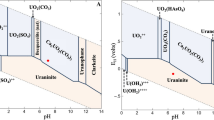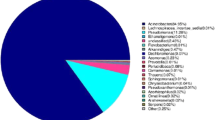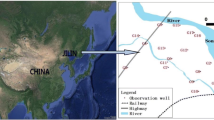Abstract
To determine whether the U(VI) in groundwater under anoxic conditions at a decommissioned in situ leaching (ISL) uranium mine could be bioreduced, groundwater samples containing suspended sediments were taken from the mine, experimental setup was fabricated, and the jar containing the groundwater in the setup was amended with ethanol and incubated under anoxic conditions. The variations of pH, chemical oxygen demand, nitrate, sulfate, U(VI), and dissolved oxygen (DO) concentrations were monitored during the incubation. U(VI) concentration dropped to 0.043 mg/L when the stimulated microorganisms were active, and it then increased to 0.835 mg/L within 10 days after the metabolism of the stimulated microorganisms was inhibited. The DO variation was observed in the amended jar during the incubation, and the metabolism of the stimulated microorganisms was found to affect the DO concentration. Firmicutes were found to be dominant in the sediments in the amended jar through the 16S rRNA pyrosequencing. The results indicate that it is possible to bioreduce U(VI) in the groundwater under anoxic conditions at the decommissioned ISL uranium mine by adding carbon source into it without removing the oxygen from it.




Similar content being viewed by others
References
Taylor G, Farrington V, Woods P, Ring R, Molloy R (2004) Review of environmental impacts of the acid in situ leach uranium mining process. CSIRO Land and Water
Osiensky JL, Williams RE (1990) Factors affecting efficient aquifer restoration at in situ uranium mine sites. Groundw Monit Rem 10:107–112
Mudd GM (2001) Critical review of acid in situ leach uranium mining: 1. USA and Australia. Environ Geol 41:390–403
Mudd GM (2001) Critical review of acid in situ leach uranium mining: 2. Soviet Block and Asia. Environ Geol 41:404–416
Vokál V, Mužák J, Ekert V (2013) Remediation of Uranium In-Situ Leaching Area at Stráž pod Ralskem, Czech Republic. In: Proceedings of the ASME 2013 15th International Conference on Environmental Remediation and Radioactive Waste Management
Lovley DR, Finneran KT, Anderson RT, Nevin KP (2002) Potential for bioremediation of uranium-contaminated aquifers with microbial U(VI) reduction. Soil Sediment Contam 11:339–357
Gihring TM, Zhang G, Brandt CC, Brooks SC, Campbell JH, Carroll S, Criddle CS, Green SJ, Jardine P, Kostka JE, Lowe K, Mehlhorn TL, Overholt W, Watson DB, Yang Z, Wu WM, Schadt CW (2011) A limited microbial consortium is responsible for extended bioreduction of uranium in a contaminated aquifer. Appl Environ Microbiol 77:5955–5965
Wu WM, Carley J, Gentry T, Ginder-Vogel MA, Fienen M, Mehlhorn T, Yan H, Caroll S, Pace MN, Nyman J, Luo J, Gentile ME, Fields MW, Hickey RF, Gu B, Watson D, Cirpka OA, Zhou J, Fendorf S, Kitanidis PK, Jardine PM, Criddle CS (2006) Pilot-scale in situ bioremedation of uranium in a highly contaminated aquifer. 2. Reduction of U(VI) and geochemical control of U(VI) bioavailability. Environ Sci Technol 40:3986–3995
Watson DB, Wu W-M, Mehlhorn T, Tang G, Earles J, Lowe K, Gihring TM, Zhang G, Phillips J, Boyanov MI, Spalding BP, Schadt C, Kemner KM, Criddle CS, Jardine PM, Brooks SC (2013) In situ bioremediation of uranium with emulsified vegetable oil as the electron donor. Environ Sci Technol 47:6440–6448
Moon HS, Komlos J, Jaffé PR (2007) Uranium reoxidation in previously bioreduced sediment by dissolved oxygen and nitrate. Environ Sci Technol 41:4587–4592
Wu WM, Carley J, Luo J, Ginder-Vogel MA, Cardenas E, Leigh MB, Hwang C, Kelly SD, Ruan C, Wu L, J VN, Gentry T, Lowe K, Mehlhorn T, Carroll S, Luo W, Fields MW, Gu B, Watson D, Kemner KM, Marsh T, Tiedje J, Zhou J, Fendorf S, Kitanidis PK, Jardine PM, Criddle CS (2007) In situ bioreduction of uranium (VI) to submicromolar levels and reoxidation by dissolved oxygen. Environ Sci Technol 41:5716–5723
Abdelouas A, Lutze W, Gong W, Nuttall EH, Strietelmeier BA, Travis BJ (2000) Biological reduction of uranium in groundwater and subsurface soil. Sci Total Environ 250:21–35
Pham D, Bargar J, Janot N (2012) Determining the elemental composition of naturally reduced sediments at Old Rifle Aquifers. SLAC National Accelerator Laboratory, Menlo Park
Suvorova E, Williams K, Lezama-Pacheco JS, Blue LY, Cerrato J, Bernier-Latmani R, Giammar DE, Long PE (2011) Speciation of uranium in biologically reduced sediments in the Old Rifle Aquifer. In: American Chemical Society Annual Meeting: Denver, CO
Qafoku NP, Kukkadapu RK, McKinley JP, Arey BW, Kelly SD, Wang C, Resch CT, Long PE (2009) Uranium in framboidal pyrite from a naturally bioreduced alluvial sediment. Environ Sci Technol 43:8528–8534
Davis JA, Curtis GP, Wilkins MJ, Kohler M, Fox P, Naftz DL, Lloyd JR (2006) Processes affecting transport of uranium in a suboxic aquifer. Phys Chem Earth Parts A/B/C 31:548–555
Campbell KM, Kukkadapu RK, Qafoku NP, Peacock AD, Lesher E, Williams KH, Bargar JR, Wilkins MJ, Figueroa L, Ranville J, Davis JA, Long PE (2012) Geochemical, mineralogical and microbiological characteristics of sediment from a naturally reduced zone in a uranium-contaminated aquifer. Appl Geochem 27:1499–1511
Banning A, Demmel T, Rüde TR, Wrobel M (2013) Groundwater uranium origin and fate control in a river valley aquifer. Environ Sci Technol 47:13941–13948
Simoni SF, Harms H, Bosma TNP, Zehnder AJB (1998) Population heterogeneity affects transport of bacteria through sand columns at low flow rates. Environ Sci Technol 32:2100–2105
Schäfer D, Schäfer W, Kinzelbach W (1998) Simulation of reactive processes related to biodegradation in aquifers: 2. Model application to a column study on organic carbon degradation. J Contam Hydrol 31:187–209
Campbell KM, Veeramani H, Ulrich KU, Blue LY, Giammar DE, Bernier-Latmani R, Stubbs JE, Suvorova E, Yabusaki S, Lezama-Pacheco JS, Mehta A, Long PE, Bargar JR (2011) Oxidative dissolution of biogenic uraninite in groundwater at Old Rifle, CO. Environ Sci Technol 45:8748–8754
Davis AC, Patterson BM, Grassi ME, Robertson BS, Prommer H, McKinley AJ (2007) Effects of increasing acidity on metal(loid) bioprecipitation in groundwater: column studies. Environ Sci Technol 41:7131–7137
Gu B, Wu WM, Ginder-Vogel MA, Yan H, Fields MW, Zhou J, Fendorf S, Criddle CS, Jardine PM (2005) Bioreduction of uranium in a contaminated soil column. Environ Sci Technol 39:4841–4847
Cardenas E, Wu WM, Leigh MB, Carley J, Carroll S, Gentry T, Luo J, Watson D, Gu B, Ginder-Vogel M, Kitanidis PK, Jardine PM, Zhou J, Criddle CS, Marsh TL, Tiedje JM (2008) Microbial communities in contaminated sediments, associated with bioremediation of uranium to submicromolar levels. Appl Environ Microbiol 74:3718–3729
Converse BJ, Wu T, Findlay RH, Roden EE (2013) U(VI) Reduction in sulfate-reducing subsurface sediments amended with ethanol or acetate. Appl Environ Microbiol 79:4173–4177
Luo W, Wu W-M, Yan T, Criddle C, Jardine P, Zhou J, Gu B (2007) Influence of bicarbonate, sulfate, and electron donors on biological reduction of uranium and microbial community composition. Appl Microbiol Biotechnol 77:713–721
Price PB, Sowers T (2004) Temperature dependence of metabolic rates for microbial growth, maintenance, and survival. Proc Natl Acad Sci USA 101:4631–4636
Boonchayaanant B, Kitanidis PK, Criddle CS (2008) Growth and cometabolic reduction kinetics of a uranium- and sulfate-reducing Desulfovibrio/Clostridia mixed culture: temperature effects. Biotechnol Bioeng 99:1107–1119
Environmental Protection Administration of China (2006) Monitoring and analysis methods of water and wastewater, 4th edn. China Environmental Science Press, Beijing
Zhou P, Gu B (2005) Extraction of oxidized and reduced Forms of uranium from contaminated soils: effects of carbonate concentration and pH. Environ Sci Technol 39:4435–4440
Phillips EJP, Landa E, Lovley DR (1995) Remediation of uranium contaminated soils with bicarbonate extraction and microbial U(VI) reduction. J Ind Microbiol 14:203–207
Ortiz-Bernad I, Anderson RT, Vrionis HA, Lovley DR (2004) Resistance of solid-phase U(VI) to microbial reduction during in situ bioremediation of uranium-contaminated groundwater. Appl Environ Microbiol 70:7558–7560
N’Guessan AL, Vrionis HA, Resch CT, Long PE, Lovley DR (2008) Sustained removal of uranium from contaminated groundwater following stimulation of dissimilatory metal reduction. Environ Sci Technol 42:2999–3004
Barton LL, Allan Hamilton e W (2007) Sulphate-Reducing Bacteria. Cambridge University Press, Cambridge
Wu W-M, Gu B, Fields M, Gentile M, Ku Y-K, Yan H, Tiquias S, Yan T, Nyman J, Zhou J, Jardine P, Criddle C (2005) Uranium (VI) reduction by denitrifying biomass. Bioremediat J 9:49–61
Atun G, Kilislioglu A (2002) The adsorption behavior of natural sand in contact with uranium contaminated seawater. J Environ Sci Health Part A Toxic/hazardous Subst Environ Eng 37:1295–1305
Chapelle FH, Bradley PM, Thomas MA, McMahon PB (2009) Distinguishing iron-reducing from sulfate-reducing conditions. Ground Water 47:300–305
Cardenas E, Wu WM, Leigh MB, Carley J, Carroll S, Gentry T, Luo J, Watson D, Gu B, Ginder-Vogel M, Kitanidis PK, Jardine PM, Zhou J, Criddle CS, Marsh TL, Tiedje JM (2010) Significant association between sulfate-reducing bacteria and uranium-reducing microbial communities as revealed by a combined massively parallel sequencing-indicator species approach. Appl Environ Microbiol 76:6778–6786
Ryan JN, Elimelech M, Ard RA, Harvey RW, Johnson PR (1998) Bacteriophage PRD1 and silica colloid transport and recovery in an iron oxide-coated sand aquifer. Environ Sci Technol 33:63–73
Okabe S, Matsuda T, Satoh H, Itoh T, Watanabe Y (1998) Sulfate reduction and sulfide oxidation in aerobic mixed population biofilms. Water Sci Technol 37:131–138
Wall JD, Krumholz LR (2006) Uranium reduction. Annu Rev Microbiol 60:149–166
Gao W, Francis AJ (2008) Reduction of uranium(VI) to uranium(IV) by clostridia. Appl Environ Microbiol 74:4580–4584
Sitte J, Akob DM, Kaufmann C, Finster K, Banerjee D, Burkhardt EM, Kostka JE, Scheinost AC, Buchel G, Kusel K (2010) Microbial links between sulfate reduction and metal retention in uranium- and heavy metal-contaminated soil. Appl Environ Microbiol 76:3143–3152
Sigalevich P, Meshorer E, Helman Y, Cohen Y (2000) Transition from Anaerobic to Aerobic growth conditions for the sulfate-reducing bacterium Desulfovibrio oxyclinae results in flocculation. Appl Environ Microbiol 66:5005–5012
Mtimunye PJ, Chirwa EMN (2014) Characterization of the biochemical-pathway of uranium (VI) reduction in facultative anaerobic bacteria. Chemosphere 113:22–29
Acknowledgments
This work was supported by the National Natural Science Foundation of China (51274124) and the Development Program for Science and Technology for National Defense (B3720132001).
Author information
Authors and Affiliations
Corresponding author
Electronic supplementary material
Below is the link to the electronic supplementary material.
Rights and permissions
About this article
Cite this article
Ding, Dx., Li, Sm., Hu, N. et al. Bioreduction of U(VI) in groundwater under anoxic conditions from a decommissioned in situ leaching uranium mine . Bioprocess Biosyst Eng 38, 661–669 (2015). https://doi.org/10.1007/s00449-014-1305-3
Received:
Accepted:
Published:
Issue Date:
DOI: https://doi.org/10.1007/s00449-014-1305-3




